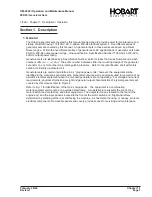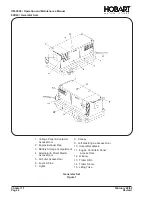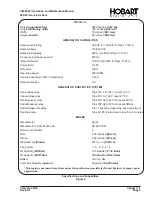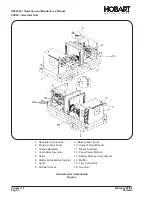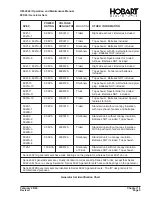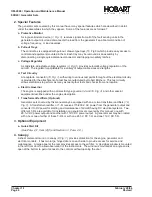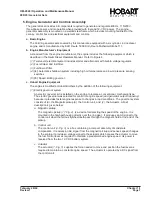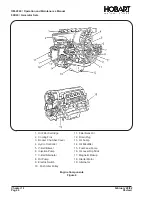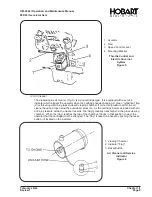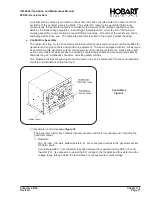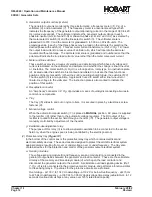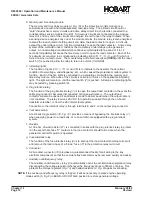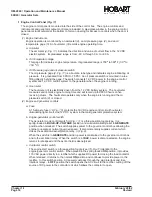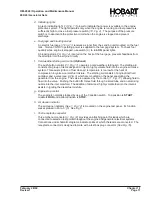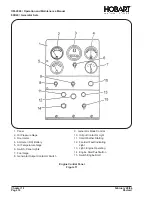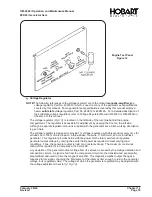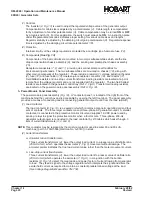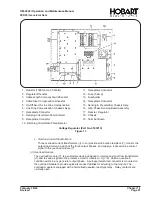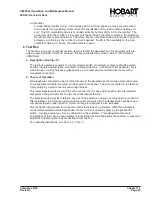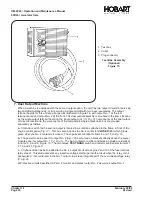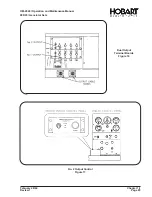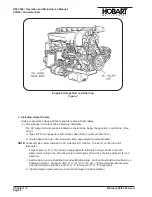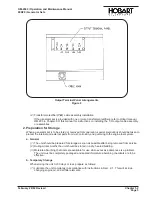
b. Memory and time delay module
The memory and time delay module
(4, Fig. 10)
or the protective monitor module, is a
solid-state device with a hermeticallysealed, reed-type relay. The printed circuit board or
“card” includes five memory circuits and a time delay circuit. Each circuit is connected to a
corresponding sensing module
(5 and 6)
. All memory circuits are connected to the module
relay coil, and any one of the circuits can energize the coil to open the relay contacts. When
a sensing device energizes any one of the module circuits, the module relay is also energized
to break the load contactor holding circuit and allow the load contactor to open. All circuits,
except the undervoltage circuit, function immediately to open the load contactor. A time delay
system of the contactor under conditions the momentary undervoltage in the generator
output. An undervoltage condition which continues uninterrupted for a period of 4 to 12
seconds
(adjustable)
will cause the time delay circuit to open the load contactor. Each of the
five circuits is connected to a corresponding indicating light
(10, 11, 13, 14, and 15)
which is
turned on when a fault occurs. The module relay will remain energized
(OPEN)
until the reset
switch
(7)
is pushed to allow the relay to return to normal,
(CLOSED)
.
c. Indicating lights
The function of lights
(10, 11, 13, 14, and 15)
is to indicate to the operator the abnormal
condition of overvoltage, underfrequency, etc., which caused the protective monitor system to
function. Each of the five lights is connected to an actuating circuit within the memory and
time delay module. When one of the circuits is activated, it turns on the applicable indicating
light. The light will remain on until the reset switch
(7)
is pushed. All lamps in indicating lights
may be tested by pressing switch
(8)
.
d. Plug interlock relay
The function of the plug interlock relay
(1)
is to open the output load contactor in the event the
cable plug connector becomes disconnected during power delivery. The output load
contactor will also be opened if an attempt is made to deliver power when the output cable is
not connected. The relay receives 28-V DC for operation supplied through the on-board
transformer-rectifier, or from the 28-Volt electrical system.
Connection to the interlock relay is through terminals E and F on the output plug connector.
e. Test bank switch
A test bank toggle switch
(18, Fig. 10)
provides a means of bypassing the interlock relay
(1)
when supplying power to a load bank, or to an aircraft not equipped with a plug-interlock
system.
f. Resistor
A 100-ohm, 25-watt resistor
(21)
is connected in series with the plug interlock relay to protect
it in the event that phase “C” contacts in the load contactor should fail to close when the
generator control ON switch is operated.
g. Fuse-interlock relay
The function of the fuse-interlock relay
(2)
is to interrupt the load contactor holding coil circuit
and remove the load in case of a “blown” fuse
(17)
in the protective relay coil circuit.
h. Connector
A 26-contact connector
(19)
provides a quick-disconnect facility for all wiring to the tray
electrical components so that the complete tray assembly may be removed quickly and easily.
i.
Auxiliary underfrequency relay
The auxiliary underfrequency relay
(3)
automatically opens the excitation-deenergization relay
disconnecting the voltage regulator whenever the frequency drops to 380 Hz or below. This
protects the voltage regulator
(Fig. 13)
and ballast resistors
(2, Fig. 8)
against overloading.
NOTE: If the auxiliary underfrequency relay is tripped, it will be necessary to place engine operating
mode switch (5, Fig. 9) in BUILD-UP-VOLTAGE position to restore generator voltage.
OM-2040 / Operation and Maintenance Manual
90D20 / Generator Sets
Chapter 1-1
February 28/94
Page 14
Revised
Summary of Contents for 6921 Series
Page 2: ...This page intentionally left blank ...
Page 223: ......
Page 224: ......
Page 225: ......
Page 226: ......
Page 227: ......
Page 228: ......
Page 229: ......
Page 230: ......
Page 231: ......
Page 232: ......
Page 233: ......
Page 234: ......
Page 235: ......
Page 236: ......
Page 237: ......
Page 238: ......
Page 239: ......
Page 240: ......
Page 241: ......
Page 242: ......
Page 243: ......
Page 244: ......
Page 245: ......
Page 246: ......
Page 247: ......
Page 248: ......
Page 249: ......
Page 250: ......
Page 251: ......
Page 252: ......
Page 253: ......
Page 254: ......
Page 255: ......
Page 256: ......
Page 257: ......
Page 258: ......
Page 259: ......
Page 260: ......


